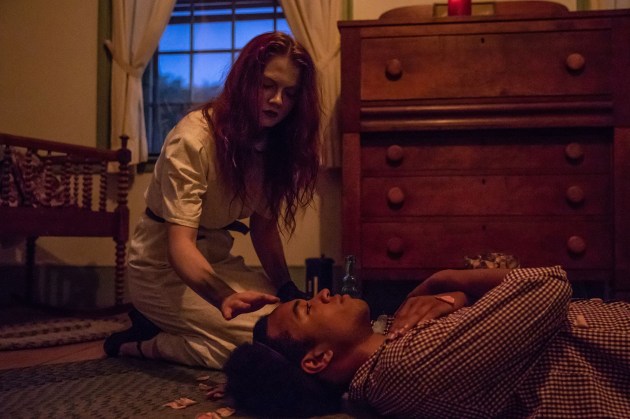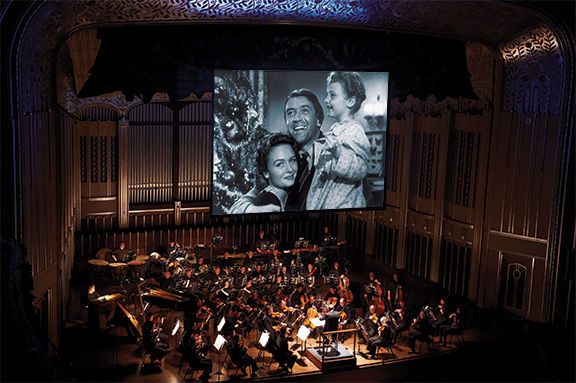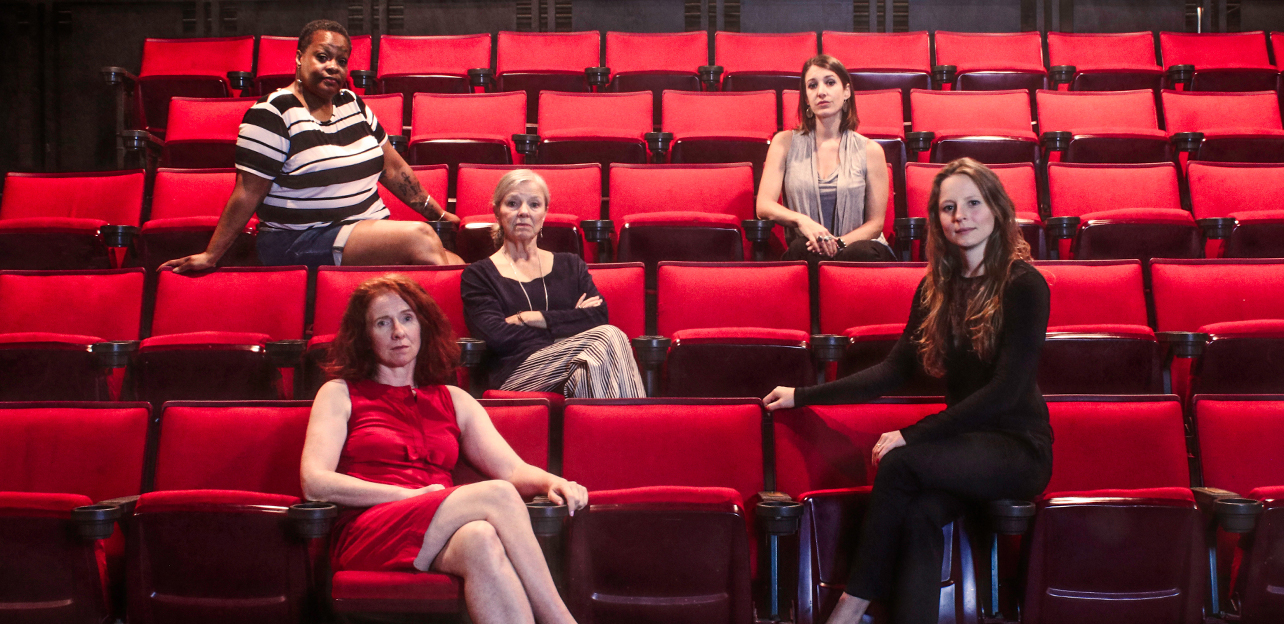
Story by Jane Kaufman
Henry Bernstein Photos / Three Driveway Media
In the 1930s, Cleveland was terrorized by a set of gruesome serial murders. Victims were decapitated, bled and dismembered.
Dubbed the torso killer or the mad butcher of Kingsbury Run, the killer was never identified despite the best efforts of then-public safety director Eliot Ness and his team.
That macabre subject serves as the backdrop and foreground for a series of immersive theater projects designed by Shadow of the Run LLC, a for-profit theater company based in North Canton.
Immersive theater is just that: Rather than having the invisible fourth wall or proscenium arch separating the audience from the action, audience members take part in some way.
The company’s first show, “Shadow of the Run Chapter 1: WanderLust,” was staged in four buildings and in open air of Bedford’s historic district in July and August.

In it, 21 actors interacted with 14 audience members – individually and as a whole – who walked in groups from scene to scene in a theatrical experience that challenged them to drink, smell, listen and observe, and play a role in the flow of the scenes. During its run, the show played 12 times an evening with start times staggered 20 minutes apart.
“WanderLust,” the first iteration of an upcoming series of theatrical experiences, created a back story for the Lady of the Lake, the first victim of the torso slayings. The culminating project of Shadow of the Run will be a full-length warehouse-sized production by the same name. That final project was the first piece written but won’t be staged for at least a year and a half. In the meantime, the theater company is in the midst of staging a series of smaller productions.
‘An actor prepares’
Michael Sharon, a retired lawyer who lives in Cleveland Heights, played the apothecary in “WanderLust.” As part of his research into the healing art, he found an apothecary shop in Bedford within walking distance of the historic district where the show was staged. The owners allowed him to use fox bones.
During his scene where audience members were directed to visit his shop and engage, he asked them to “cast the bones,” or pour them from a canister onto a table. As some might read palms or tea leaves, Sharon says he used the pattern the bones formed to determine how to customize sachets for audience members seeking protection.
“The spirit in the bones would tell me,” he says.

The Lady of the Lake was a so-called Jane Doe, and writer Beth McGee imagined her as a young woman from Bedford striking out for Cleveland. Similarly, Sharon, who acts in traditional theater as well, created a back story for his character as the town attorney and sometimes apothecary, the maternal grandson of Romani, who taught him about herbs and sachets.
In his role, Sharon had one-on-one encounters with members of the audience, quite different from delivering lines from a stage. A hallmark of immersive theater is that it requires a heightened and intimate level of audience interaction.
Sharon says he enjoys the experience and prefers it to traditional acting. Dealing with the unexpected may be important for actors in this sort of theater, but timing is critical.
“I have done litigation during my career, and it does help,” he says. “Anybody who’s got the ability to think on their feet is going to be better served in this type of theater. A good actor is going to live in their character a little bit.”
Logistics and special effects
Every scene had to run like clockwork in ‘Wanderlust.’ A synchronized soundscape provided cues to the actors about when each scene needed to close, a device commonly used in immersive theater.
“Everything was done meticulously so that we know where every given patron and actor is at any given moment,” says Ben Needham, production designer.
Because of the close proximity of the audience, special effects must hold up under scrutiny, including makeup and prosthetics, says Christine Woods, co-owner, designer and escape room designer; the final production will include two escape rooms.
“There’s the saying in theater – it only has to look good 30 feet away and four feet up,” she says, adding that maxim doesn’t apply to immersive theater. “People know that it’s not real, but you don’t want it to pull them out of the experience.”
Another challenge in setting the stage and preparing the actors is conveying the rules of engagement to the audience.
“We want people to be able to intuitively understand the rules,” Woods says. “That’s always a challenge because this is still a young medium where we’re still trying to learn from other people.”
In immersive theater, actors will sometimes invite experience through touch.
“We’re trying to make sure that they engage but don’t engage in a harmful way,” she says. “There are some spaces where it’s OK to touch things. And there are other spaces where that’s a real antique and we don’t want to mess with it.”
Lighting can help, as can staging.
“The more we can do with managing their attention in a way that they aren’t even interested in touching that thing over there, the more we win,” Woods says.
“We were fortunate enough to have the resources of the Bedford Historical Society at our disposal. So we had a series of buildings that were all from the 1800s that we were to actually put our show inside of,” Needham says. “So instead of creating a train station from scratch, like we would in theater and film, we actually were able to use a historical train station for one of the locations. It was really well received because no one had seen anything like this.”
After the show, audience members often spent hours comparing their different and shared experiences.
How it started
Created in London in 2000, the concept of immersive theater first came to the attention of Adam Kern in 2009, when American Repertory Theater brought “Sleep No More” from London to the Old Lincoln School in Brookline, Mass.
At the time, Kern was in graduate school working on his Master’s of Fine Arts at the American Repertory Theater Moscow Art Institute for Advanced Theater Training at Harvard University in Cambridge, Mass.
“Getting to see my classmates and friends work on that production led me on a trip to kind of see more immersive theater,” he says. “I also worked with an immersive haunted house called Blackout. … Those two things combined, and seeing immersive (theater) around the country, just made me want to be involved in it.”
After the North Canton native returned from Los Angeles in December of 2015, he wanted to launch immersive theater localy. He decided to reach out to McGee, a theater professor at Case Western Reserve University in Cleveland, whom he met in 2002. At that time, they were working on “Big River” at the Porthouse Theatre in Cuyahoga Falls and later collaborated on other theater projects.
A week after he returned to North Canton, Kern called McGee to ask if she would write the show.
“And without missing a beat – and I don’t know why because this hadn’t been a fascination for me or anything – I said, ‘Well if I’m going to write an immersive theater piece in Cleveland, I want to write it about Eliot Ness and the Cleveland torso killer,’” McGee recalls.
Six months later, her full-length piece, ”Shadow of the Run,” was finished, and the company launched in late 2017, with four co-owners: Kern, McGee, Needham and Woods. Based in North Canton, the limited liability corporation is a bit unusual for an arts organization. It is structured as a business, and it pays every member of its cast and crew.

Art as inspiration
McGee says her inspiration for the topic came from a 2010 multi-media installation called “An Invitation to Lubberland” by Duke Riley shown at the Museum of Contemporary Art, Cleveland. That installation focused on Kingsbury Run, a river that has been diverted underground. In the 1930s, the intersection of Kingsbury Run and the Cuyahoga River was home to a homeless persons’ camp.
“And that’s where the torso killer was preying on people,” McGee says. “I was fascinated by that history by going to the exhibit, and that’s what I think fueled my idea.”
Casting ‘Wanderlust’ proved particularly challenging, says Kern, the director, because the green light for the show came less than two weeks before it went into rehearsals. He says future shows will be easier to cast now that local actors have been exposed to immersive theater.
“We had a lot of actors come through as audience members and reach out to us saying, ‘Hey, when can I do this, how can I audition?’” Kern says. “So, I think a little bit more time and notice and we will not have any issue with that. But for a first-time company, it was a little scary having to go into a first rehearsal casting two or three roles.”

What’s in store
The hope is to stage the full warehouse-sized, “Shadow of the Run,” as an ongoing or permanent production in Cleveland, possibly in 2021, Kern says.
A pop-up show, “Railroaded: A Shadow of the Run Story” will be staged, tentatively from Jan. 9 through Jan. 12, 2020 at a location to be announced.
Those who attended “WanderLust” can take part in an internet game or puzzle starting in late November or early December, leading up to “Railroaded,” Woods says. Others may take part in that game as well, although Woods says attendees of “WanderLust” may have a leg up.
McGee says “Railroaded” will center on the village at Kingsbury Run where some of the body parts were found.
“In the 1930s … Cleveland was considered a welcoming town to hobos,” McGee says. “There were three railroads that all crossed through that area of Cleveland, and so it was easy for the hobos to jump off and camp.”
McGee is just starting to write the script for ‘Railroaded,” having won funding in early November.
She says “Shadow of the Run Chapter 2: Calloused” will feature Eliot Ness as a character, tentatively scheduled for summer of 2020.
The title, “Calloused,” comes from a quote by Ness.
“You think eventually that nothing can disturb you and that your nerves are impregnable,” Ness is quoted as having said. “Yet looking down at that familiar face, I realize that death is something to which we never become calloused.”










